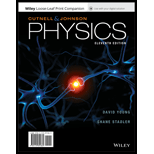
The correct option for change in average power dissipated in the resistor when the frequency is doubled and the rms voltage is tripled.
Answer to Problem 1FC
The correct option is (d). The average power increases by a factor 32 = 9 because it proportional to the square of the rms voltage.
Explanation of Solution
Given data:
A circuit contains an ac generator and a resistor.
Frequency is doubled and the rms voltage tripled.
Formula used:
Write the expression for average power delivered.
Here,
Explanation:
In general, the value of resistance is independent of frequency of AC generator. Therefore, average power of the circuit with resistance is independent of frequency.
Substitute
Therefore, by doubling the frequency and tripling the rms voltage, the average power increases by a factor
Conclusion:
Hence, the correct option is (d). The average power increases by a factor 32 = 9 because it proportional to the square of the rms voltage.
Want to see more full solutions like this?
Chapter 23 Solutions
Cutnell & Johnson Physics - Eleventh Edition
 College PhysicsPhysicsISBN:9781305952300Author:Raymond A. Serway, Chris VuillePublisher:Cengage Learning
College PhysicsPhysicsISBN:9781305952300Author:Raymond A. Serway, Chris VuillePublisher:Cengage Learning University Physics (14th Edition)PhysicsISBN:9780133969290Author:Hugh D. Young, Roger A. FreedmanPublisher:PEARSON
University Physics (14th Edition)PhysicsISBN:9780133969290Author:Hugh D. Young, Roger A. FreedmanPublisher:PEARSON Introduction To Quantum MechanicsPhysicsISBN:9781107189638Author:Griffiths, David J., Schroeter, Darrell F.Publisher:Cambridge University Press
Introduction To Quantum MechanicsPhysicsISBN:9781107189638Author:Griffiths, David J., Schroeter, Darrell F.Publisher:Cambridge University Press Physics for Scientists and EngineersPhysicsISBN:9781337553278Author:Raymond A. Serway, John W. JewettPublisher:Cengage Learning
Physics for Scientists and EngineersPhysicsISBN:9781337553278Author:Raymond A. Serway, John W. JewettPublisher:Cengage Learning Lecture- Tutorials for Introductory AstronomyPhysicsISBN:9780321820464Author:Edward E. Prather, Tim P. Slater, Jeff P. Adams, Gina BrissendenPublisher:Addison-Wesley
Lecture- Tutorials for Introductory AstronomyPhysicsISBN:9780321820464Author:Edward E. Prather, Tim P. Slater, Jeff P. Adams, Gina BrissendenPublisher:Addison-Wesley College Physics: A Strategic Approach (4th Editio...PhysicsISBN:9780134609034Author:Randall D. Knight (Professor Emeritus), Brian Jones, Stuart FieldPublisher:PEARSON
College Physics: A Strategic Approach (4th Editio...PhysicsISBN:9780134609034Author:Randall D. Knight (Professor Emeritus), Brian Jones, Stuart FieldPublisher:PEARSON





